In November 2016, when my account balance stopped at 987U, I stared blankly at the MACD indicator on the screen. The day before, I had just lost 3000U because 'I didn't understand the top divergence', and at that moment I vowed: 'Either I thoroughly grasp these signals or I completely exit the crypto space.' Now, my account has stabilized at over 10 million U, increasing 200 times, not by guessing ups and downs, but by turning 'divergences, golden crosses, and stop losses' into reflexes — just like hitting the brakes when seeing a red light while driving, simple enough not to require thought.
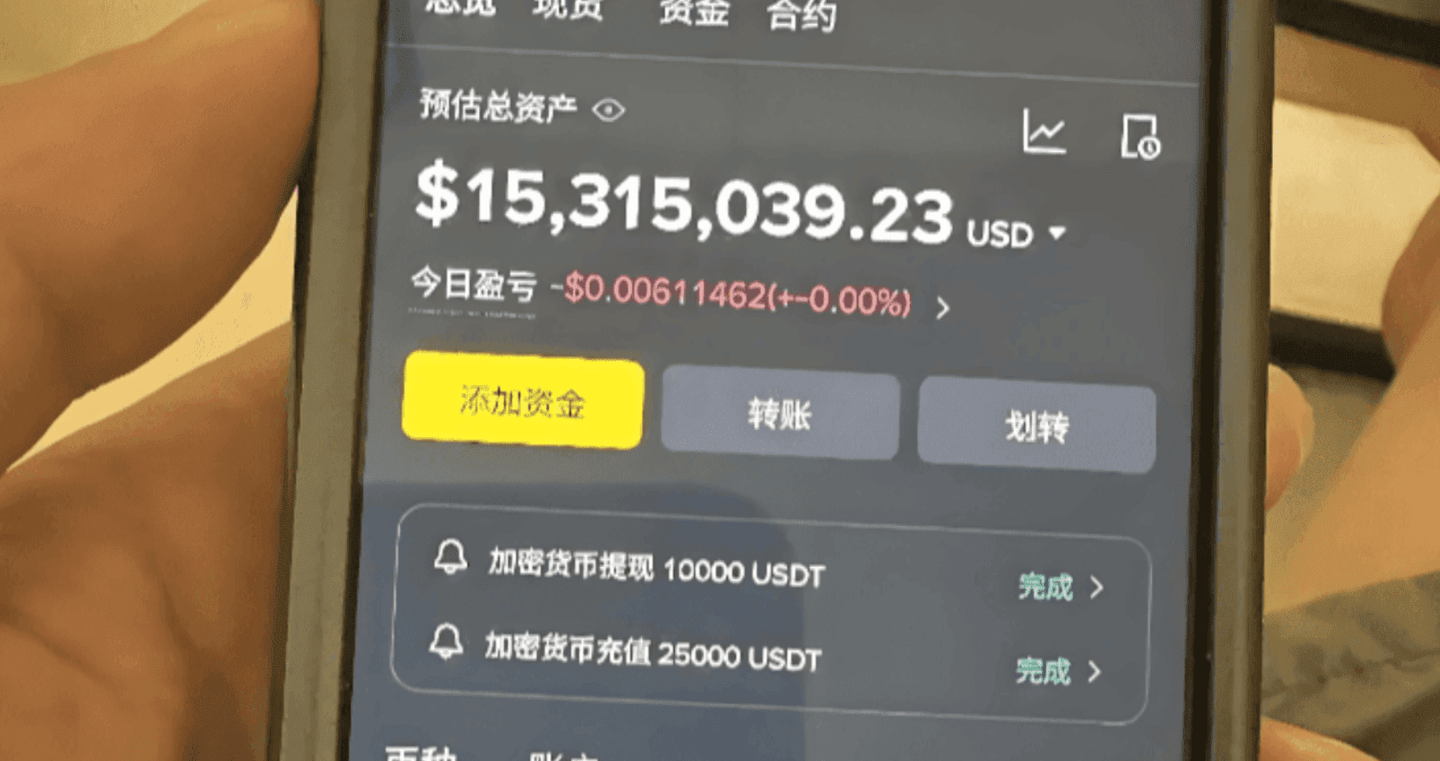
One, top divergence: escaping the peak in 2021 made $4 million; this signal is sharper than an alarm.
What is top divergence? Price surges to new highs like a mad dog (for example, BTC from $60,000 to $69,000), but the MACD red bars get shorter like a deflated balloon, with the yellow and white lines 'unable to move' at high levels. At this time, never trust the group shouting 'breaking $100,000'; the main force is secretly unloading.
During that bull market in 2021, I made a fatal mistake:
On June 10, BTC reached a new high of $69,000, with a floating profit of $4 million;
MACD red bar shrinks from 50 to 20, yellow line is 10 points lower than the previous high;
The group was full of profit screenshots, but I recalled the crash during the top divergence of ETH in 2018 (from $1400 to $800).
At 2 AM, I gritted my teeth and cleared 70% of my position. The next day BTC plummeted 58%, and the remaining 30% was also cleared during the second top divergence, ultimately preserving $3.2 million. Later, when reviewing DOGE's trend, I found the same signals:
$0.35 new high, the red bar is 40% shorter than the previous high;
Within 3 days it dropped to $0.1, everyone who bought the bottom was buried.
Top divergence escape steps (note this down):
Open the 4-hour K-line, draw new high points in price and MACD red bar high points;
New high in price but red bars shortening → mark 'one divergence';
Second divergence occurs (price makes new high, red bars shorter) → sell 50%;
Yellow line death cross (crossing below white line) → clear the remaining 50%.
Student Akai avoided the crash of SOL in 2024 with this trick. He said: 'I used to think that 'selling would leave me empty-handed', but now when I see red bars shortening, my hands shake, and I reflexively want to close my position.'
2. Bottom divergence: Buying bottom in LUNA made $1.5 million, relying on 'green bars shortening'
When LUNA dropped to $0.0001 in 2023, the community was full of 'zeroing' wails. But when I opened MACD, I saw:
Price creates a new low of $0.0001;
Green bar length shrinks from -60 to -15 (getting shorter);
The yellow line flattens at a low level without making new lows.
This is bottom divergence — the market has stopped falling, and the main force is secretly accumulating chips. I built positions in 3 batches:
First bottom divergence → use 5% position (50U) to test the waters;
Second bottom divergence (price drops again, green bars shorter) → Add 10% position;
Yellow line golden cross → add another 15% position.
After one month, LUNA rebounds to $0.01, making $1.5 million from this 30% position. But there is a prerequisite: only trade coins with 'two or more divergences'; a single divergence may be a trap (for example, a certain altcoin in 2024 fell 80% after a single bottom divergence).
Bottom divergence buying rule:
Must wait for 'three consecutive shortening of green bars' K lines;
Combine with trading volume (decreasing volume when falling, increasing volume when rising);
Only touch coins in the top 50 by market cap; small-cap coins are prone to false divergences.
Three, don't rush into golden crosses: After losing $200,000 on PEPE, I learned that the second golden cross is the real opportunity.
When PEPE first golden crossed in 2024, I rushed in and lost $200,000. Later I found out:
At the time of the first golden cross, OKEx hot wallet had $20 million coming in and out (main force trial trading);
Trading volume did not increase, and the red bar shrank as soon as it appeared;
30-minute line and 4-hour line are not synchronized (30-minute golden cross, 4-hour still death cross).
The real opportunity appears at 'the second golden cross':
After the first golden cross, a pullback occurred but did not break the previous low;
The 30-minute and 4-hour lines synchronize golden cross;
Trading volume suddenly increases to three times the usual (real funds entering).
Entering the market at this time, I made $800,000 in 5 days. It's like starting a car; the first time may stall, but the second time pressing the gas is steady.
Golden cross entry Checklist:
□ 30-minute and 4-hour lines sync golden cross;
□ Trading volume ≥ three times the usual;
□ Hot wallet net inflow (non-demo);
□ The length of the red bar exceeds the previous golden cross.
Four, stop loss and take profit: the 'life-saving formula' taught by a billionaire with a net worth of $600 million
From $1000 to $200,000, the most painful pit I stepped into was 'not stopping losses'. Now, using this formula, stop losses and take profits are as mechanical as clocking in:
1. Top divergence + large whale outflow = immediately cut positions.
When a top divergence occurs, and over $5 million in net outflow from whales is observed on-chain → clear positions;
For instance, when ETH showed top divergence in 2024, V God’s address transferred out 10,000 coins → cleared positions that day, avoiding a 15% drop.
2. Three-cycle resonance = lock in positions
Use the 30-minute line to determine direction (golden cross for long, death cross for short);
4-hour line looks at strength (red bar length ≥ previous high);
Weekly trend lock (do not act if there is no top divergence).
During the main rising wave of SOL last year, I used this trick to achieve a 300% increase, and I wasn't washed out in between.
3. Three consecutive stop losses = stop trading for 24 hours
In 2023, I experienced five consecutive stop losses; if I had held on, I would have lost 80%. Later, I set a rule:
Three consecutive stop losses → close software for 24 hours;
During the review, draw the 'error map' (for example, print out PEPE's false golden cross and stick it on the wall).
5. Position control: From liquidation 3 times to $200,000, relying on 'starting with 5%'
The initial position should never exceed 5%, a lesson learned from liquidation:
With a principal of 1000U → never exceed 50U for each trade;
Make a profit of 10% and then increase the position (use profit to add, not principal);
Stop once total positions reach 50% (leave 50% to respond to pullbacks).
Student Xiao Wang initially didn't believe it and opened a position with 30% leverage, losing $2000 after one stop loss. Later, he switched to 5% leverage and grew from $5000 to $80,000 in 6 months.
Finally, here are three action instructions for $1000 players:
Tonight, open the trading software and find 3 top divergence cases (like DOGE, PEPE), draw them on paper;
Set an alarm: Check 'whale fund flow' before each trade (recommended Nansen tool);
Set 'stop trading after three consecutive stop losses' as your phone wallpaper.
The secret to making money in the crypto world lies in 'turning signals into reflexes'. Now when I see top divergence, it feels like seeing a red light; I close my position without thinking — this muscle memory is more reliable than any 'expert prediction.'
Beyond the K-line: a journey about trading and life~
Ten years ago, I boarded a train south with a naive longing for the future. The gears of fate quietly turned one morning when my fingertips first touched those dancing numbers, not expecting this would become a lifelong practice.
Now I've found a home by the Xiangjiang River, and the two cars in the garage are merely tools for transport. The rise and fall of account numbers no longer stirs ripples in my heart. Behind the glamour seen by outsiders are countless days and nights dancing with K-lines, teaching me not how to quickly accumulate wealth, but how to coexist gently with this world.
Daily trading: Practicing with solitude
The city sleeps in the night at three in the morning, with the blue light of the screen reflecting my focused face. In this industry, there is no concept of 'staying up late', only the market's pulse beating day and night. Having seen too many peers aged by the pressure, I am fortunate to maintain a sense of ritual in life, not to please others, but to remind myself not to lose my way in the maze of numbers.
The exchanges of cups and plates at the social table pale in comparison to the quiet review at the desk. Even in noisy situations, the vibration of the phone in my pocket feels like an invisible thread pulling at my concern for the market. The trust placed in me has long transformed into the responsibility on my shoulders, making me wary of a moment's negligence. Most of the time, a day's trajectory begins with interpreting policy news and ends with organizing trading notes, interspersed with countless trend analyses.
Pressure is like air, permeating every moment of trading. Initially attempting to resist, later learning to accept, ultimately understanding that true strength is to keep the heart as solid as a rock. Short-term operations require constantly capturing battle opportunities; the notification sound of news windows rises and falls, but compared to responding to the market's rapid changes, taming the heart that always wants to 'seize every opportunity' is even more challenging.
The survival philosophy the market taught me
Abandon subjective speculation to hear the market's voice. Having stubbornly believed that a certain coin would rise against the trend, reality taught a profound lesson — when personal judgment goes against market sentiment, learning to submit is the wise move. Just like a ship must follow the current in stormy weather, the essence of trading is to dance with the trend, not to fight against it.
The significance of setting stop-loss lines goes far beyond simple risk control. That string of numbers is not just the safety margin of the account, but a reminder of self-greed. How many times have I felt lucky when touching the stop-loss point, only to realize that decisively exiting is the most responsible attitude towards funds? The market will only reward those who adhere to discipline.
Stick to the cognitive boundary and calmly accept mistakes. Judgments formed through rigorous analysis are worth executing firmly; even if the results are not as expected, it is a necessary path for cognitive upgrade. The outcome of trading does not rely on single gains or losses but on maintaining the consistency of the system, just as an old farmer does not abandon the规律 of farming due to a drought.
Life wisdom read from K-lines
When the torrent of trading data washes over the soul, it instead clarifies the essence of life. I began to view the world with probabilistic thinking, understanding that certainty is merely an accident, while uncertainty is the norm. This cognitive shift is like a key, unlocking a new dimension of life — fastening a seatbelt is no longer just for compliance checks, quitting smoking is not merely a forced endeavor, treating others well is not moral constraint, but a natural choice.
On the desk, there is a jade inscription that reads 'Modest Gentleman', a reminder to myself. Suddenly one day I realized, when making money becomes as easy as breathing, life loses the joy of exploration. So I began practicing calligraphy on rice paper, sketching shadows in a drawing book, and searching for the wisdom of sages in ancient books. These moments, unrelated to money, bloom with the truest happiness.
The market is like a mirror reflecting every wrinkle in the heart. When you are eager for quick success, it teaches you a lesson; when you are greedy, it takes back its gifts; when you try to conquer, it will ultimately make you understand the meaning of reverence. The warnings left by predecessors are not alarmist; if speculation exceeds the growth of the soul, it will eventually lose direction at some corner.
The practical art of unity of knowledge and action
The gap between thought and action is the biggest enemy in trading. How many can accurately predict the market but shrink back in execution; how many strategies are flawless in review but fall apart in practice. This internal tug-of-war is essentially a conflict between human weaknesses and trading discipline. Those who can cross this gap have long won against most opponents.
When the market is chaotic, staying still is the best strategy. Just like a hunter remains silent when no prey appears, true traders understand how to wait in uncertainty. Those who constantly want to 'not miss any opportunity' often exhaust their capital and energy in frequent operations. The market's rewards are always reserved for the patient, not the busiest.
The importance of independent judgment far exceeds that of collective consensus. I have seen too many people seeking others' approval in decision-making, ultimately losing their way amidst conflicting opinions. Each person's risk tolerance, capital scale, and operational system are different; strategies suitable for others may not be suitable for oneself. The lessons learned from miscommunication are far more valuable than guessing the market, as the former can be distilled into experience, while the latter is merely futile prophecy.
The underlying logic for survival in the crypto world
The secret to stable profits lies in repeating simple correctness thousands of times. Just like an old craftsman refining his skills, a trading system also needs to be tempered over time. The essence of technical analysis is not complex formulas, but the intuition of simplifying complexity. When a certain pattern appears, the body's reaction is quicker than the mind's thought.
Faith in the system must transcend emotional fluctuations. The market will always present various temptations that make you doubt the effectiveness of established strategies, but those rules verified by time are often more reliable than momentary intuitions. Patience during holding and decisiveness during exiting are equally important. Profits are 'sat' out, not 'made' out; this is a compulsory lesson for every long-term trader.
Risk control always takes precedence over profit. Behind price fluctuations is a game of probability; there is no such thing as absolute certainty, which is precisely the meaning of stop-loss existence. True wealth accumulation starts with knowing how to preserve capital, rather than pursuing exorbitant profits. Just like a sailor must first ensure the ship does not sink, a trader's top priority is to survive in the market.
Four realms of mindset cultivation
Clarity in profit is rarer than resilience in loss. The market's rewards often hide traps, and those who amplify positions due to temporary gains will ultimately be bitten by greed. Maintaining humility is not a facade, but an understanding that every decision may have blind spots. Only by respecting the market can one endure.
Calmness after losses is a prerequisite for turning the tables. An urgent desire to recover losses can lead to greater mistakes, just like gamblers are more likely to go all in during a losing streak. True traders understand that accepting losses is part of the game, just as farmers accept the natural cycle of droughts and floods. Adjusting mindset and starting anew is much more meaningful than being entangled in the past.
Slow is fast's dialectical philosophy. Wealth accumulation is like bamboo growth; in the first four years, roots grow underground, and only in the fifth year does it shoot up. Those chasing short-term profits often falter amidst volatility, while the stable growth of compound interest will eventually reveal the magic of time.
Viewing price fluctuations with a calm mind allows for stability and longevity. Excessive focus on account fluctuations can cause a loss of judgment due to anxiety. Just as a climber does not stop due to loose stones underfoot, traders should not let short-term fluctuations disrupt their rhythm. True investment is a marathon; temporary leads or lags do not count. Only those who reach the finish line are winners.
Life awakening beyond trading
When the brush tip spreads ink on the rice paper, when the piano keys flow out simple melodies, when the mountains and waters in the twilight come into view, I suddenly understand: beyond the K-line chart, there are broader horizons. The wisdom and beauty accumulated by human civilization are far more worth pursuing than the ups and downs of numbers.
This journey that began for profit ultimately leads to inner abundance. Trading taught me not how to conquer the market, but how to reconcile with myself; not how to predict the future, but how to live in the moment. When making money is no longer the only goal, life presents richer possibilities.
Perhaps this is the ultimate meaning of investment: to see oneself clearly in the torrent of numbers, to cultivate the inner self through the fluctuations of the market, and ultimately understand — the highest form of trading is to treat the world gently.
Making $1 million in the crypto world, 'either rely on a big bull market + hold on, or rely on hitting the jackpot coin, or leverage to bet on the right direction.' But most people lose money, so don't just look at the stories of getting rich; first, think about how much risk you can bear.
If you are also a tech enthusiast in the crypto world, click on the coin homepage.
Click on the profile picture to follow me for first-hand information and in-depth analysis!
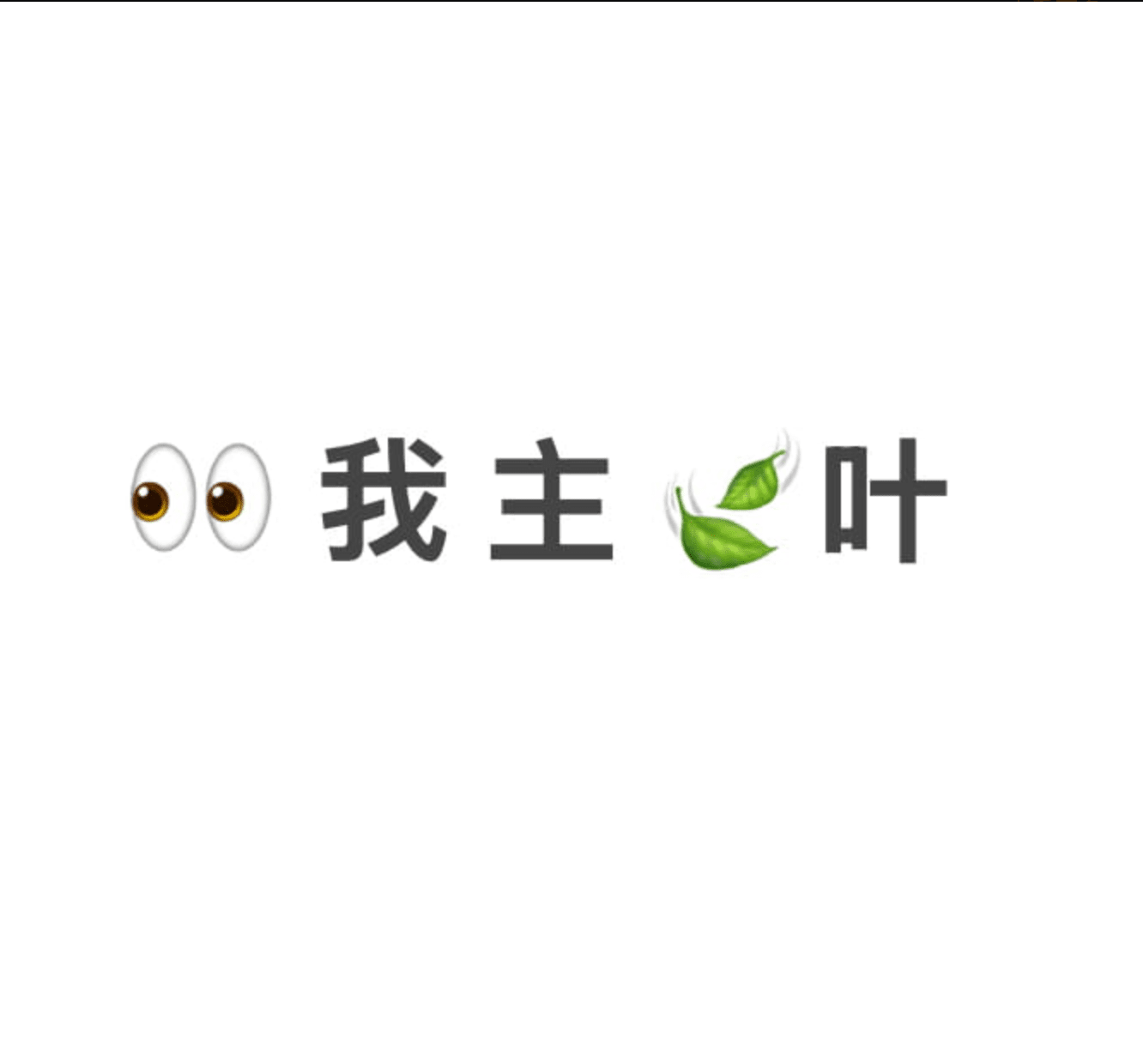
After liquidation, I realized from a 1500% return account that trading is a system, not a price.
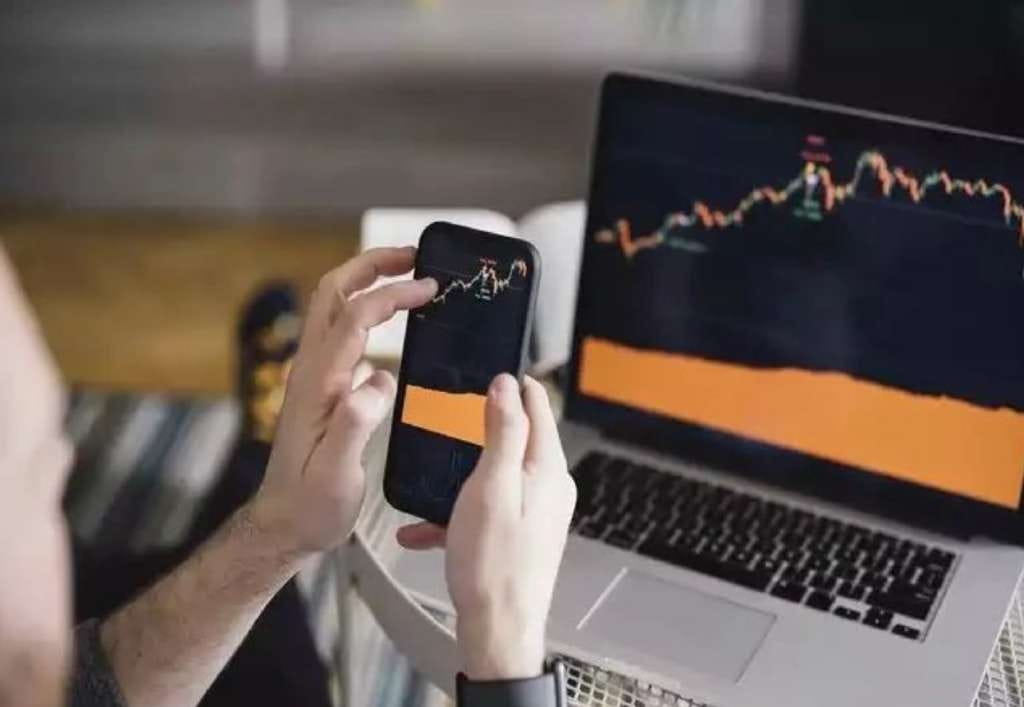
When discussing liquidation, I demonstrated my mistakes in 10 ways, for example:
I bought at this price too late;
Short-term double kill, didn't hold on;
Stop loss set too small, just hit the stop loss and then rebounded, etc.
........
After I finished speaking, I asked: What do you think? My friend pondered for a moment and replied: I don't think much; trading is not just about price, but about the system, but I didn't hear you have a trading system.
Later, he elaborated on the rules of the trading system in detail, which benefited me greatly. I summarized it briefly and shared it with everyone.
1. With a trading system, even a novice can profit.
Many people believe that trading is about making profits through price fluctuations.
However, price volatility itself carries significant uncertainty; whether in technical or news aspects, there will always be a certain deviation from expectations, and how you view this deviation directly affects your trading outcomes.
What is required here is not only the skill to read charts, but also the timing for opening and closing positions, position management, and mindset. This is the trading system.
The earliest trading system, I believe, is the grid trading method. Find a volatility range, divide it into many equally spaced grids, and set up the initial position. For every grid drop, buy in, and for every grid rise, sell out.
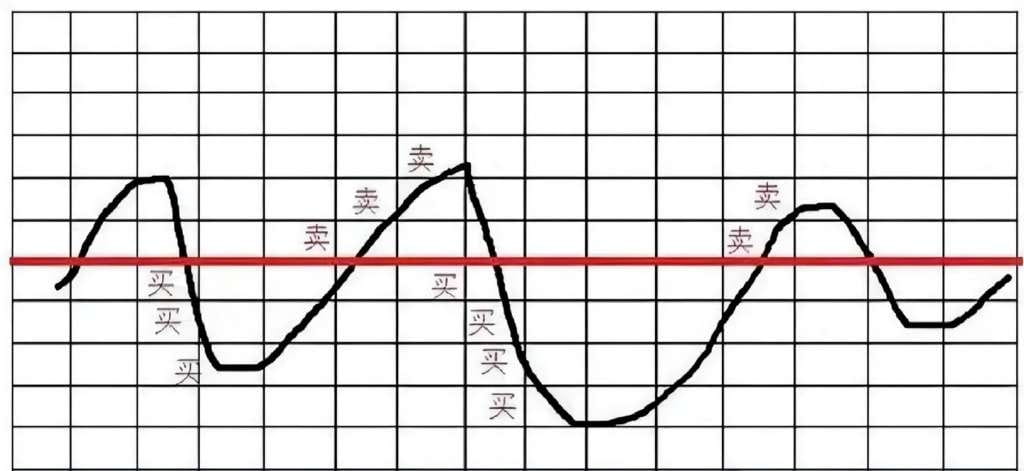
The inventor of the grid trading method is American mathematician Shannon, who knew nothing about the market yet slaughtered it in the stock market using the grid trading method, which is astonishing.
But if you review afterward, you will find that the grid trading method did at least three things right:
Adhere to discipline and trade according to the grid;
Not influenced by human nature, do not arbitrarily add positions;
Strict position management; Shannon's strategy uses the Kelly formula f=(pb-q)/b to calculate the optimal holding ratio.
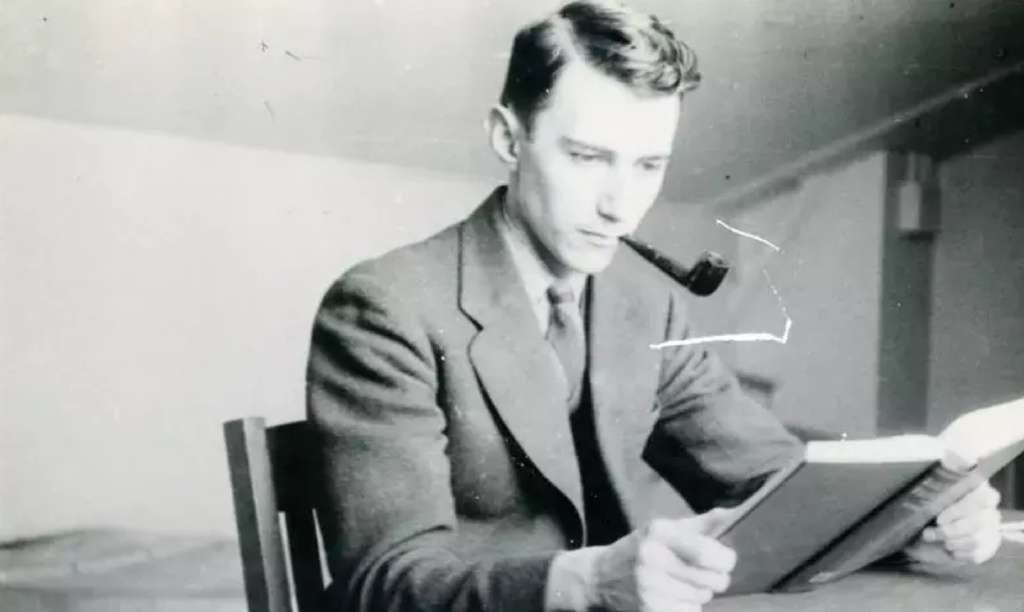
This basically covers all the elements a trading system needs to have. Therefore, it is not price, but the system that allows 'novice' Shannon to succeed in the market.
2. It is a system, not a price.
Traders with a trading system never complain about the price at which they bought.
For example, in the following market, according to Dow theory on normal uptrends, the highs and lows should rise simultaneously. If you are an aggressive investor, you might consider shorting when the price breaks below position 1.
If you are a bit more cautious, prices 2 and 3 correspond to the previous stage bottoms, both are entry opportunities.
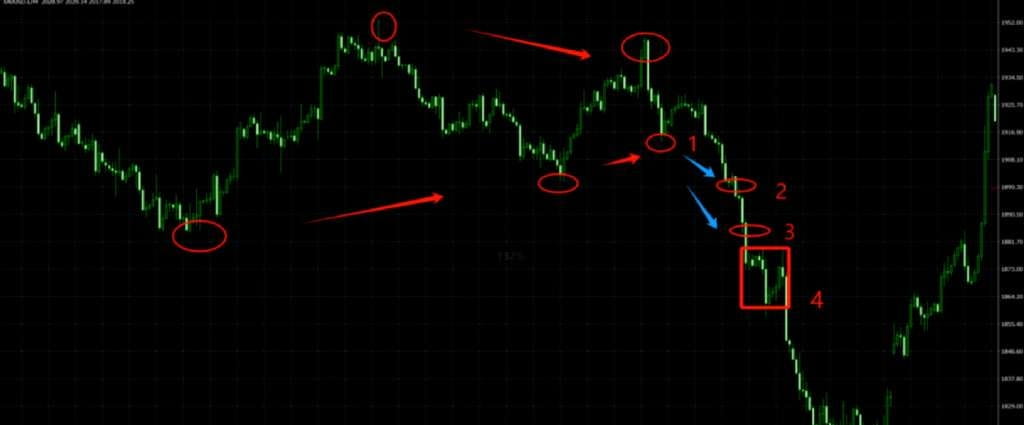
If you still missed it, and the market failed to form a bottom at price 4, there will be another short opportunity as the large bearish candle pulls through. You see, in a trending market, as long as your trading system has one or several entry indicators, you will eventually participate as long as you strictly follow your system.
This is also not absolute; as mentioned earlier, price is also uncertain. For instance, at the end of this market, despite the overall flattening and signs of bottoming, it still conforms to the downward trend. If you unfortunately short here, your stop loss will determine the degree of your loss control.
I recommend setting stop losses at 20%-30%, as this aligns well with the 3:1 risk-reward ratio requirement. A 3:1 risk-reward ratio ensures that even with multiple losses, you can safeguard your capital, which is commonly stated as 'as long as you make 3 out of 10 trades right.'
If your trading system has such triggering mechanisms, your losing positions will exit near 1850. But don't panic, as you will soon find that the market has created a normal upward trend again, breaking through previous resistance at prices 1, 2, and 3, all of which are great entry points.
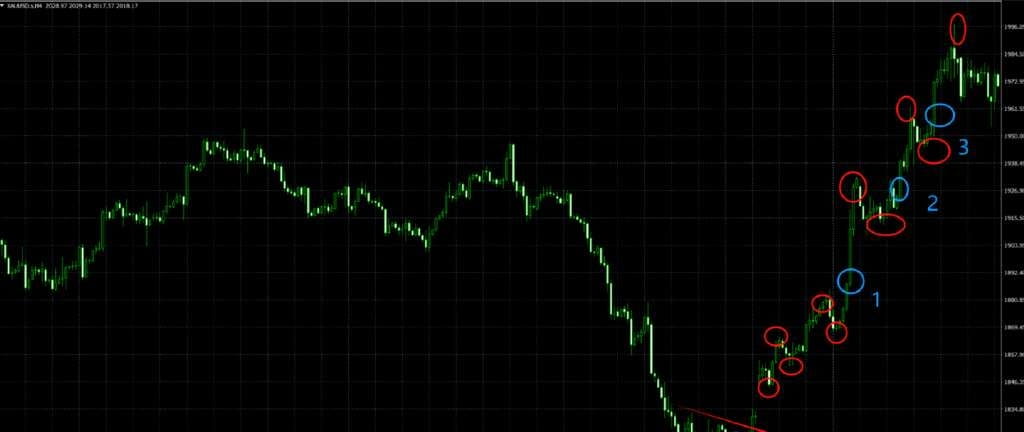
A mature trading system must have a complete mechanism for triggering entries, exits, stop losses, and take profits. Once these mechanisms form a closed loop, they will continuously provide you with trading opportunities.
This market segment is based on a 4-hour capture and is representative of trading between short-term and daily trading. Some experienced investors will also calculate the strength of rebounds and pullbacks based on the frequency of 4-hour volatility points.
Three, protect capital and profits
Trading is for profit, but more importantly, it is to protect capital.
The author of the theory of intertwining has repeatedly mentioned that only zero-cost trading is without risk. In simple terms, it means using profits to trade after accumulating profits. Even if there are losses, as long as the principal remains, there are still infinite possibilities in the future.
Of course, it is difficult for ordinary investors to trade this way, but learning to exit in batches is also a very necessary part of improving the trading system.
For example, in this market, if you bought at the top, consider leaving the market at positions 1, 2, and 3, as key support and resistance positions often have dense orders and are prone to price reversals. By exiting in batches, you can ensure profit protection at different extension positions.
Four, learn to coexist with oscillations
Price fluctuations can be divided into oscillations and trends, but oscillations account for 70%, while trends only 30%. Therefore, most of the time, the market does not offer us excitement, but rather oscillating consolidation.
But this does not mean that there are no trading opportunities in oscillations. In a 30-point market, as long as you confirm the range and buy high and sell low, repeatedly carrying out this tedious process can also accumulate profits.
Once a breakout occurs, it is mostly the end of the consolidation market, entering a short-term trend. At this time, trade in the direction of the trend, manage stop losses and take profits well, and always pay attention to the return of oscillations. This is a complete trading cycle. If you understand these, your trading system can switch freely in different stages of the market.
This concept was actually first demonstrated in Wyckoff's price cycle. The consolidation range corresponds to the accumulation area and distribution area, while the trending market occurs when there is an imbalance between supply and demand.
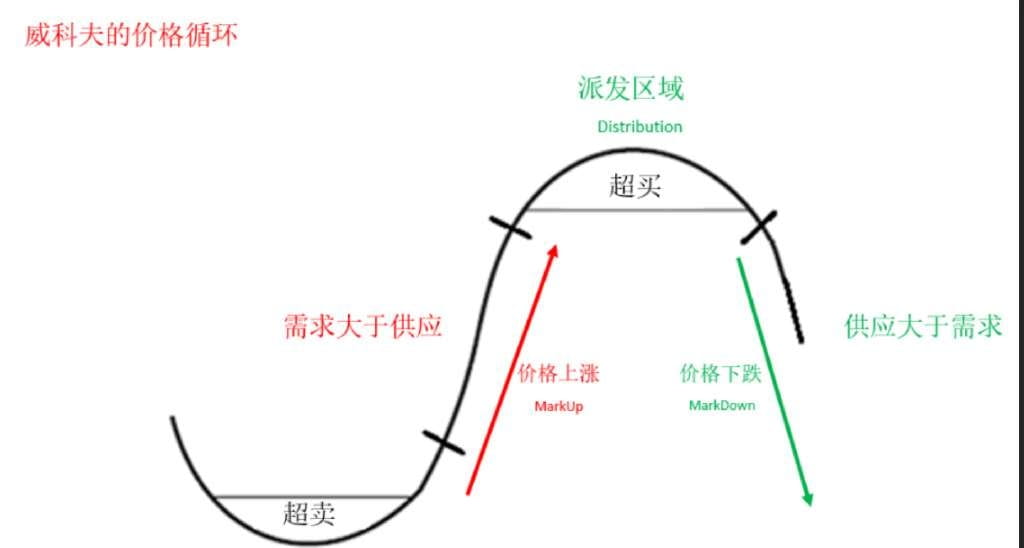
The difficulty in oscillating markets is how to identify false signals.
In Wyckoff trading method, it is believed that there will be a spring effect, meaning the market will briefly drop below the oscillation range but will later rebound from the bottom of the range to the top. The spring effect is a process of shaking out positions, so it does not last long. Therefore, in your trading system, in addition to setting stop losses, you need to identify price signals when breaking out.
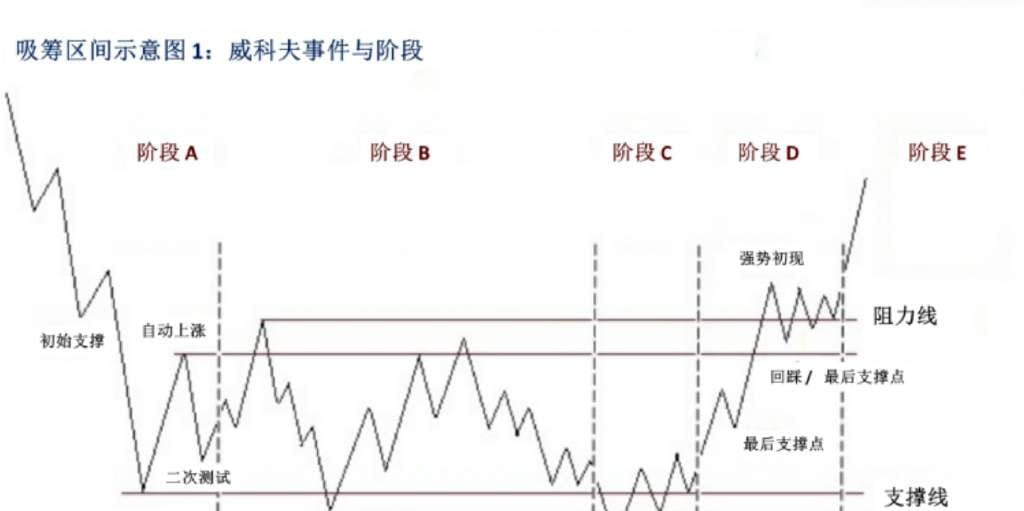
When multiple K-lines appear outside the oscillation range and repeatedly test without returning above the range, it indicates a valid breakdown; otherwise, it is a process of shaking positions. A mature trading system will also consider the factor of time in addition to price.
In (Wyckoff 2.0), you will see higher-level judgment methods regarding accumulation and distribution, introducing trading volume data within the framework of time and price.
Through trading volume, you will find that the consolidation range is precisely the area of concentrated chips. Typically, market initiation occurs because one party has digested the other's chips and grasped the price's initiative. Therefore, prices breaking out of the range usually happen with reduced volume.
Therefore, by analyzing the densely packed trading volume areas, we can determine the value range in advance and understand the fluctuation range, providing a reference for grasping oscillating markets.
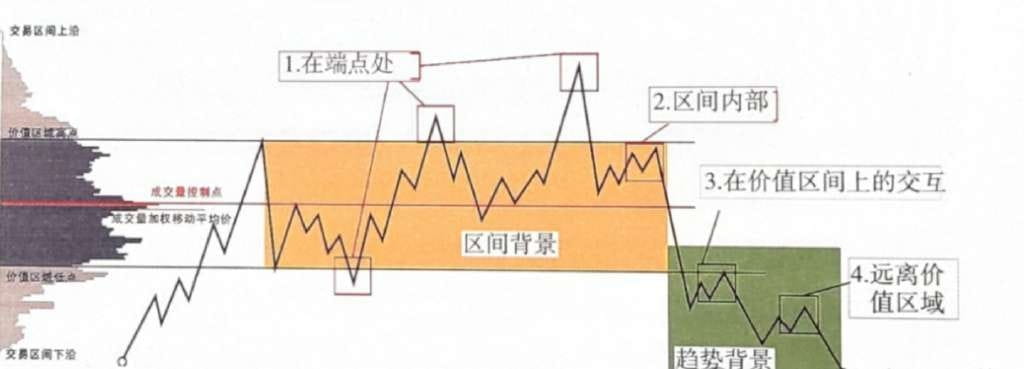
Finally, I particularly like a saying: a trading system is a set of rules that monitors market trends while constraining human nature.
A trading system is a complex collection that encompasses skills, mindset, and self-discipline. Many may not lack understanding of market logic and may even be well-versed in various technical analysis rules. However, they cannot overcome human weaknesses, chasing highs and lows, exiting for small wins, and holding large losses, repeatedly missing opportunities when facing market uncertainty.
However, the best way to avoid uncertainty is to face it head-on, controlling risks with take profits and stop losses, protecting capital and profits through batch exits, and strictly adhering to trading discipline, so that thinking can truly become a manual for profit.
One image to understand: the 4% fixed investment method, easy for beginners to achieve passive income! Suitable for all traders in confusion!
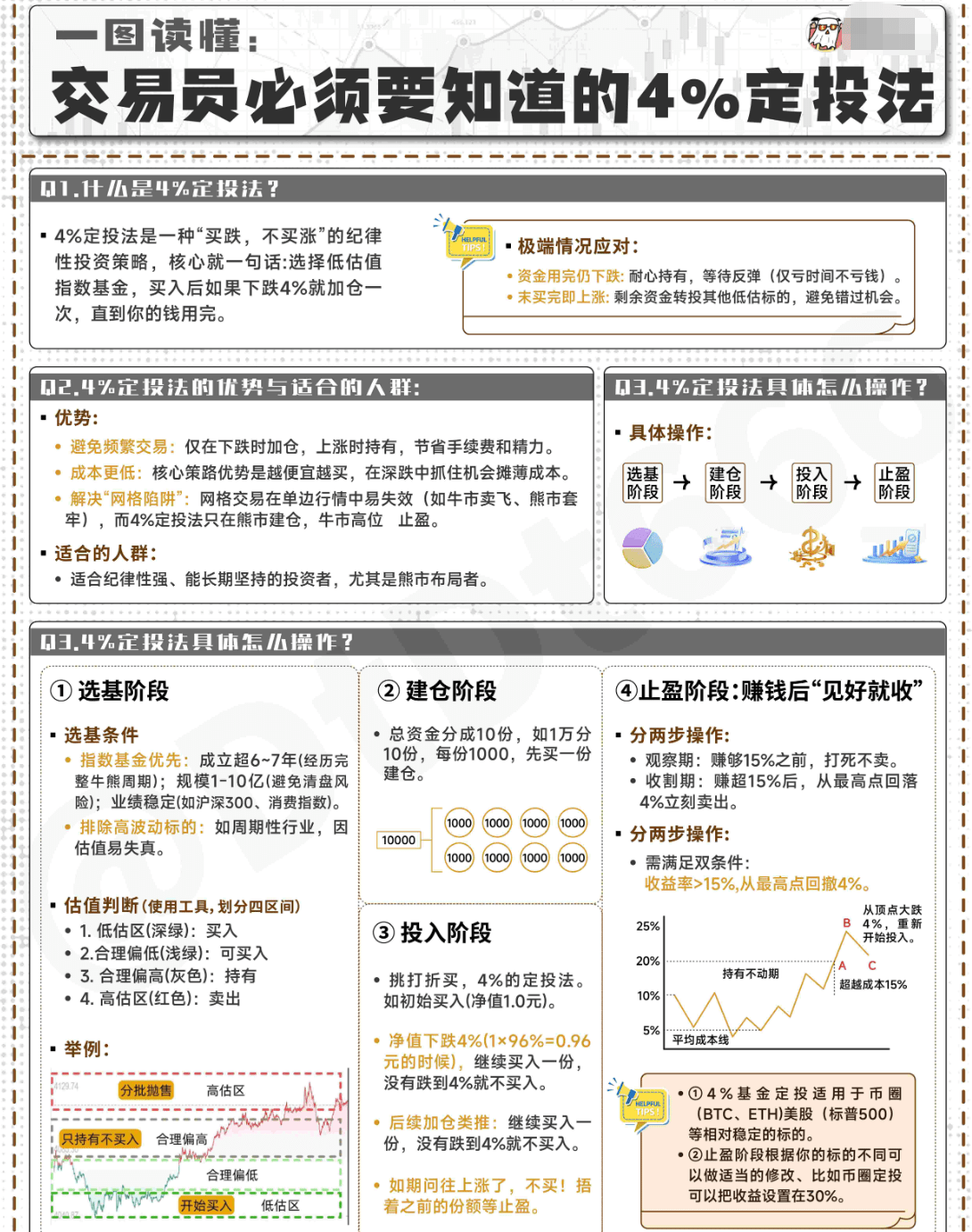
① When the market is falling, you can always collect enough cheap chips.
② When the market starts to rebound, it is always possible to quickly break even and generate profits.
③ Mindset is surprisingly good, truly achieving happiness whether the market rises or falls.
④ Long-term return levels far exceed ordinary investors.
Unlike traditional weekly or monthly fixed investments,
The core of the 4% fixed investment method is 'only buy on dips, not on rises'.
Only when the market drops 4% will it trigger the additional position operation.
The three key stages of the 4% fixed investment method:
Phase One: Position building. Divide your investment capital into 10-15 equal parts, investing one part each time. For example, if you plan to invest 100,000 yuan, each part will be 10,000 yuan.
Phase Two: Investment. Starting from the last lowest point, every time the market drops 4%, invest one part. For example, if point B is the last lowest point, when the market drops 4% and reaches point F, buy one part at point F. Note that no buying occurs at point D (only buy if it has dropped 4%).
Phase Three: Take profit. If your profit has not reached 10-30%, remain inactive; once profit reaches 10-30%, observe further, waiting for the market to pull back 4% from the highest point, then sell to take profit, and start a new round of fixed investment after the market drops 4%.
Making $1 million in the crypto world, 'either rely on a big bull market + holding on, or rely on hitting the jackpot coin, or leverage to bet on the right direction.' But most people lose money, so don't just look at the stories of getting rich; first, think about how much risk you can bear.
If you are also a tech enthusiast in the crypto world, click on the coin homepage.
Click on the profile picture to follow me for first-hand information and in-depth analysis!